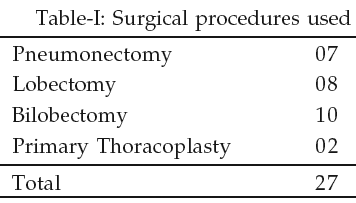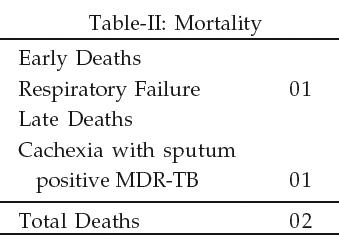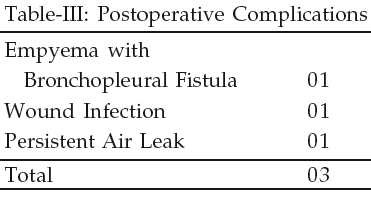|
||||
|
Published by : PROFESSIONAL MEDICAL PUBLICATIONS |
||||
|
ISSN 1681-715X |
||||
|
||||
|
- |
||||
|
ORIGINAL ARTICLE |
||||
|
- |
||||
|
Volume 24 |
April - June 2008 (Part-II) |
Number 3 |
||
|
|
||||
|
|
||||
|
||||
|
Published by : PROFESSIONAL MEDICAL PUBLICATIONS |
||||
|
ISSN 1681-715X |
||||
|
||||
|
- |
||||
|
ORIGINAL ARTICLE |
||||
|
- |
||||
|
Volume 24 |
April - June 2008 (Part-II) |
Number 3 |
||
|
|
||||
|
|
||||
Surgical interventions in multidrug-resistant tuberculosis:
retrospective analysis of 27 patients treated at a
Tertiary Level Care Center
Amer Bilal1, Abdul Baseer2,
Mohammad Muslim3, Faridullah4,
Arshad Javaid5, MZ Afridi6, MY Khan7
Abstract
Objective: To assess the results of surgery for Multidrug- Resistant Tuberculosis (MDR-TB).
Methodology: Retrospective analysis was done in 27 cases of multidrug- resistant tuberculosis in whom some surgical interventions were carried out at Department of Thoracic surgery, Lady Reading Hospital Peshawar between the years 2002 to 2007. There were 18 male and 9 female patients in the age group of 14-54 years. All were sputum positive at the time of surgery. Majority of patients were treated with pulmonary resections (pneumonectomy [n=07], bilobectomy [n=08] and lobectomy [n=10]), while primary thoracoplasty with apicolysis was done in two patients. Post operatively 2nd line anti tubercular chemotherapy was prescribed for 24 months.
Results: There was one early and one late death. Postoperative complications were seen in three cases. One patient developed bronchopleural fistula with empyema. At a mean follow-up of one year bacteriological cure was achieved in 24 patients.
Conclusion: Judiciously performed adjuvant surgery can yield excellent long term bacteriological cure with acceptable mortality and morbidity in multidrug-resistant tuberculosis. Morbidity and drug compliance remain as problem areas.
KEY WORDS:
Multidrug resistant-tuberculosis, Pulmonary resection, Thoracoplasty.Pak J Med Sci April - June 2008 (Part-II) Vol. 24 No. 3 351-355
How to cite this article:
Bilal A, Baseer A, Muslim M, Faridullah, Javaid A, Afridi MZ, et al. Surgical interventions in multidrug-resistant tuberculosis: retrospective analysis of 27 patients treated at a Tertiary Level Care Center. Pak J Med Sci 2008;24(3): 351-5.
1. Amer Bilal,
2. Abdul Baseer,
3. Mohammad Muslim,
4. Faridullah,
1-4: Dept. of Thoracic Surgery, PGMI,
Lady Reading Hospital,
Peshawar - Pakistan.
5. Arshad Javaid,
6. MZ Afridi,
7. MY Khan,
5-7: Pulmonology,
PGMI,
Peshawar - Pakistan.
Correspondence
Dr. Amer Bilal
E-mail: aamirct@hotmail.com
* Received for Publication: February 25, 2008
* Revision Received: April 25, 2008
* Revision Accepted: April 29, 2008
Introduction
From starting as collapse therapy
1 to becoming superfluous in the post streptomycin era, surgery in tuberculosis has tended to have come the proverbial full circle in the wake of multidrug-resistant tuberculosis (MDR-TB). MDR-TB, defined as tuberculosis showing resistance to, at least, isoniazide and rifampicin irrespective of resistance to other drugs is a serious threat to tuberculosis control world- wide. The World Health Organization (WHO) estimates that 50 million people worldwide are already infected with drug-resistant tuberculosis.2,3 Countries and regions are named "hot spots" where MDR-TB makes up more than 3% of the new TB cases. For example, in Estonia nearly 37 percent of the new TB cases were resistant to at least one drug. Resistance to all four drugs tested was 8.5 percent among new tuberculosis patients and the country had the highest level of MDR-TB (14.1 percent) of any area of the world among TB patients who had never been treated before.4 WHO survey in 1997, found 1.4 million drug-resistant tuberculosis cases in China.5 In India, with the largest burden of TB in the world, over 400,000 people dies from TB each year.2 WHO surveyed the state of Tamil Nadu and found another MDR-TB hot spot with 3.4 percent of new cases found to be multidrug resistant. According to the WHO, levels of MDR-TB will reach an alarming state in South East Asia if prompt steps are not taken.4 The incidence of TB increases rapidly in settings where TB control is poor, patients are immuno-compromised and also among those with HIV/AIDS or malnutrition.2 Globally, an estimated 20% of patients with TB default, or fail to respond to therapy and develop MDR-TB.3,6 With the population of 152 million, Pakistan ranks eighth among the list of 22 TB high burden countries (177 per 100,000) and death toll due to TB mounts to around 50,000 annually.7Resistance to TB drugs has been widely reported from various parts of the country, Commonest risk factor for the development of MDR-TB is a previous exposure to anti-tuberculous therapy (ATT) and of late, human immunodeficiency virus (HIV) infection has emerged as an important predisposing factor.
8 The medical treatment for MDR-TB is prolonged, toxic and suboptimal with predicted success rate of less than 50% vis-à-vis over 90% success for drug susceptible strains.8,9 Increasingly, since the last decade in particular, surgical interventions are being employed in the overall management of MDR-TB, with good results.10-13Multidrug-resistant tuberculosis is a serious threat to tuberculosis control worldwide with ominous implication in Pakistan context. The medical treatment of this disease is expensive, toxic and, most unfortunately, far from satisfactory. In carefully selected cases adjuvant surgery plays very significant role in achieving bacteriological cure. Here is the report of our experience with surgical interventions in cases of MDR-TB, carried out at our tertiary level health care centre.
METHODOLOGY
Computerized clinical data of patients with MDR-TB in whom surgical interventions was done were retrospectively analyzed. Between the years 2002 to 2007, 27 patients underwent surgical procedures for MDR-TB. There were 18 males and 09 female patients in the age group of 14-54 years. The mean follow-up period was one year. All patients were HIV negative. None of the patients had any gross evidence of bilateral disease.
Patients were comprehensively evaluated by the medical and surgical chest specialists and the decision for surgical interventions was jointly taken in all cases. The work-up included baseline laboratory investigations, sputum studies, chest radiograph, contrast enhanced computerized tomography (Thorax), bronchoscopy and spirometry. All patients were routinely tested for HIV. Pre-anaesthetic check ups were done to assess their fitness to withstand the surgical procedure. Their sputums were positive for mycobacterium tuberculosis and sensitivity tests were requested, which confirmed their MDR-TB Status.
Preferably three months of individually tailored 2
nd line ATT was prescribed, in consultation with the referring pulmonologist, except in emergency state when earlier intervention was necessary. Informed consent included detailed discussion with patients with particular emphasis on the importance of chest physiotherapy perioperatively, cessation of smoking where applicable and the necessity of continuation of 2nd line ATT for further 24 months postoperatively. Most of the patients were nutritionally depleted and efforts were made to ensure as much restoration of general health as possible.Persistence of sputum culture positive MDR-TB after three to six months of planned chemotherapy was the main indication of surgery in either cavitatory or destroyed lung lesions. Surgical procedures were mainly of resectional nature, namely pneumonectomy, bilobectomy or lobectomy, depending upon the extent of the disease.
In two emergency cases with hemoptysis where general condition of the patient was poor for major resection alternative intervention as primary thoracoplasty with apicolysis was done. Resectional surgeries were carried out using double lumen endotracheal tube under general anesthesia through standard posterolateral thoracotomy.
Pre-emptive measures, such as Intercostal flaps, were used with the initial operation to protect the bronchial stumps. Resected specimens were routinely sent for histopathological examination and AFB staining. Post operatively 2
nd line ATT was continued for 24 months after sputum conversion.On follow-ups, chest x-rays were ordered and sputum was examined for AFB at one, three, six and twelve months and at the completion of chemotherapy. Disease cure was taken with three consecutive sputum reports were negative and failure was defined with sputum positivity, whereas sputum conversion after a documented sputum negative report constituted relapse.

Results
In our study there was one early postoperative death occurring within 30 days of surgery and one late death (Table-II), translating into 3.70% early and 3.70% late mortality. Post operative complications (Table-III) included bronchopeural fistula [BPF] with empyema one, wound infections one and persistent air leaks one. Wound infection was managed conservatively while air leaks responded to prolonged intercostals tube drainage. Bronchopleural fistula with empyema was treated by open drainage [pleurocutaneous flaps].

Initially all alive 25 patients were sputum negative at one, three and six months postoperatively but later on one of them changed to positive status after 12 months of follow-up. Hence on the whole sputum could be made negative in 24/25, while two patients died.

Discussion
Surgery plays an important role in the overall management of MDR-TB with acceptable mortality and morbidity.
8,10,13 Surgical interventions, in carefully selected cases, along with 2nd line ATT appears as the most favorable option since even the best available medical therapy alone provides bacteriological cure in the order of 44-77% vis-à-vis more than 90% success rate with adjuvant surgery.8Overall mortality is no longer a prohibitive issue, with most series reporting under 3% early mortality
12,13 and we were also able to ensure acceptable operative death despite poor general health of our patients.Though operative mortality has decreased but significant morbidity continues to be nagging problem of surgery in tuberculosis being reported in about 20-25% of cases in many series
8,14,15 and at least claimed as 15% of major complications by others.12,13 Such complications have similar spectrum in most reports, BPF with empyema formation being the most distressing manifestation. Prophylactic use of inter costal muscle flap to re enforce bronchial stump reduces the incidence of post operative broncho pleuro fistula, as is evident from series, with 01 BPF out of 25 resections, treated by open drainage [pleurocutaneous flaps] doing fine during follow-up.Given that poor nutritional status and sputum positivity at the time of surgery are found to have been associated with higher rate of complications, we believe the morbidity in the present series is self-explanatory.
Unequivocal consensus is lacking in the literature regarding the application of preoperative chemotherapy. The rationale behind selecting the exact timing of intervention needs to be logical and scientific and whereas it appears logical to use surgery after a defined induction phase timings needs to be worked out. Generally accepted timing of surgery is after three months of carefully prescribed 2
nd line ATT, achieving optimal bacterial suppression at the time of surgery to a point where the bacillary load is not at a perilous high.10,12,16 Continuation of drugs for 18-24 months postoperatively seems reasonable by most authors8,10,12,16 and we advise postoperative chemotherapy for 24 months from the time of documented sputum negativety. Given the economics involved, completion of this task is frankly daunting, if not utopian, in our subset of patients. This is an ongoing study; one year follow-up has been completed while second year follow-up is in process.Indications of surgery in MDR- TB remain a contentious issue. However broad consensus is apparent in this context at least in lateralized disease and generally accepted indications include
8,10,12-16: a) high risk of treatment failure/ relapse, including history of two or more relapses or one or more relapse while on therapy, and persistently positive sputum despite 4 to 6 months of treatment and b) localized lesion. Other advocated indications have been c) intolerance to medication6 and d) bilateral disease with cavitatory lesions on one side and infiltrative lesions on the other.10,16 In our series non-resolving MDR was the main indication of surgery in either cavitatory or destroyed lung lesions. We did not operate on bilateral lung disease.Bacteriological cure in many series has been fairly impressive, with well over 90% success achieved with adjuvant surgery.
2 Most such series are from the western world and there is no significant Pakistani data to compare with our one case of failure to convert. We feel that this may be due to poor drug compliance and presence of active lung lesion in patient of thoracoplasty in our series. Perhaps more such studies from Pakistani centers will help us to realize the actual potential of adjuvant surgery in MDR- TB in Pakistan.Conclusions
MDR TB is an ever increasing threat in Pakistan. Chemotherapy alone is costly, toxic and prolonged with <50% success rate. Surgery combined with 2nd line ATT, in carefully selected patients, yields a >90% success rate with acceptable morbidity and mortality.
References
1. Alexander J. The Collapse therapy of Tuberculosis Springfield: Charles C Thomas 1937.
2. Espinal MA, Simonsen L, Laszlo A, Boulahbal F, Kim SJ, Reneiro A, et al. For the WHO/International Union Against Tuberculosis and Lung Disease Global Working Group on Anti-tuberculosis Drug Resistance Surveillance. Anti- tuberculosis drug resistance in the world. Report No. 2. Geneva: World Health Organization; 2000. Unpublished document WHO/TB/2000.278. Available from: URL: [www.who.int/gtb/publications/dru].
3. Pablos-Mendez A, Gowda DK, Frieden TR. Controlling multidrug-resistant tuberculosis and access to expensive drugs: A rational framework. Bull World Health Organ. 2002;80:489-95; discussion 495-500.
4. WHO Report 2002.Global Tuberculosis Control: Surveillance, Planning, Financing WHO/CDS/TB/2002.295.
5. World Health Organization. WHO report on the tuberculosis epidemic, 1997 Geneva: WHO 1997.
6. Dye C, Scheele S, Dolin P, Pathania V, Raviglione MC. For the WHO Global Surveillance and Monitoring Project. Global burden of tuberculosis. Estimated incidence, prevalence and mortality by country. JAMA 1999;282:677-86.
7. WHO Global DOTS expansion plan, program in the TB control in high burden countries, WHO/CDS/2001.
8. Loddenkemper R, Sugebiel D, Brendel A. Stategies against multidrug resistant tuberculosis. Eur Respir J 2002;20:66S-77S.
9. MDR-TB Fact sheet, American Lung Association, March 2005.
10. Pomerantz M, Maden L, Goble M, Isemen M. Surgical intervention in the treatment of pulmonary disease caused by drug resistant mycobacterium tuberculosis. Am Rev Respir Dis 1990;141:623-5.
11. Albino JA, Reichman LB. The treatment of Tuberculosis. Respiration 1998;65:237-55.
12. Pomrantz BJ, Cleaveland JC, Olson HK, Pomerantz M. Pulmonary resection for MDR-TB. J Thoracic Cardiovasc Surg 2001;121:448-53.
13. Takeda S, Maeda H, Hayakawa M, Sawabata N, Maekura R. Current surgical intervention for multidrug resistant tuberculosis. Ann Thorac Surg 2005;79:959-63.
14. Shiraishi Y, Nkajima Y, Katsuragi N, Kurai M, Takahashi N. Resectional surgery combined with chemotherapy remains the treatment of choice for multidrug resistant tuberculosis. J Thorac Cardiovasc Surg 2004;128:523-8.
15. Leuvan MV, Groot MD, Sheen KP, Von-oppell UO, Willcox PA. Pulmonary resection as an adjunct in the treatment of multidrug resistant tuberculosis. Ann Thorac Surg 1997;63:1368-72.
16. Parek SK, Lee CM, Heu JP, Song SD. A retrospective study for the outcome of pulmonary resection in 49 patients with multidrug resistant tuberculosis. Int J Tuberc Lung Dis 2002;6:143-9.
HOME | SEARCH | CURRENT ISSUE | PAST ISSUES
Professional
Medical Publications
Room No. 522, 5th Floor, Panorama Centre
Building No. 2, P.O. Box 8766, Saddar, Karachi - Pakistan.
Phones : 5688791, 5689285 Fax : 5689860
pjms@pjms.com.pk